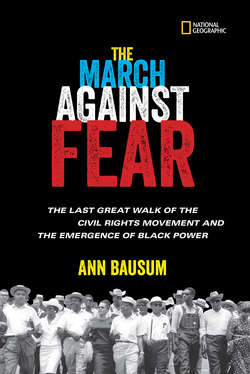Читать книгу The March Against Fear: The Last Great Walk of the Civil Rights Movement and the Emergence of Black Power - Ann Bausum, Ann Bausum - Страница 9
PROLOGUE A TREMOR BLAM!
ОглавлениеOne minute James Meredith was walking along a rural road in Mississippi, two days into an estimated two-week-long journey to the state capital of Jackson. The next minute a stranger had climbed out of the roadside honeysuckle and started shooting at him.
The first blast from the 16-gauge shotgun spewed tiny balls of ammunition toward the hiker, but the pellets struck the pavement nearby, not Meredith himself.
Undeterred, the gunman fired again.
BLAM!
Some pellets found their mark.
BLAM!
Shotgun pellets from the third blast penetrated Meredith’s scalp, neck, shoulder, back, and legs. His hiking companions seemed frozen in place, transfixed by shock and unable to react to the sudden threat.
Meredith had cried out in surprise when the shooting began. Then he, like those walking with him, began searching for cover. He dragged himself across the pavement, trying to put distance between himself and his attacker. He collapsed on his side, sprawled upon the grassy shoulder of U.S. Highway 51, his blood oozing from multiple wounds into the red soil of Mississippi.
The penetration of countless tiny balls of shot through his skin left Meredith moaning in pain. “Get a car and get me in it,” he implored the others at the scene. An ambulance arrived quickly, and within minutes Meredith was being raced back along his hiking route, bound for a Memphis hospital. Emergency room physicians concluded that his wounds were not life-threatening, although they could have been if the shooter had been closer or his aim more accurate.
James Meredith collapsed in the road after he was ambushed and shot in rural Mississippi on June 6, 1966. Credit 2
Doctors shaved the back of Meredith’s head and dug as many as 70 pellets out of his scalp, back, limbs, even from behind an ear, before they questioned their effort. Although only a fraction of the 450 or so shotgun pellets fired toward Meredith had found their mark, countless balls of shot remained embedded in his flesh. Yet it was so time-consuming—and so painful—to remove them, that doctors decided to leave the rest alone. He wouldn’t be the first person to walk around with bird shot under his skin. Soon after, a local news reporter found a medical resident familiar with the case and asked him about the patient’s condition. The doctor-in-training replied with a candor that, although shocking today, would have seemed unremarkable at that time in the South. “If he had been an ordinary nigger on an ordinary Saturday night,” the man observed, “we’d have swabbed his ass with merthiolate [an antiseptic] and sent him home”
But Meredith was not an ordinary man, black or otherwise, and his shooting would have a seismic influence on the turn of events beyond his own world.
“I wanted to give hope to a barefoot boy. I was a barefoot boy in Mississippi myself for 16 years.”
James Meredith, explaining one of the reasons behind his planned walk through Mississippi
James Howard Meredith graduated from Ole Miss in Oxford amid a sea of white faces on August 18, 1963. He was the first African American to earn a degree from the institution, having integrated it the previous year. Credit 3
